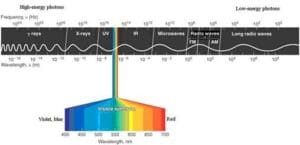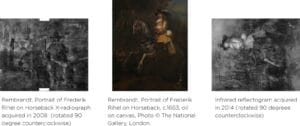Use of Infrared and X-Rays in Artworks
We are impressed when we see a work of art on a visit to a museum. What about the structure of that work of art that our eyes cannot see? To answer this question, a look outside the limited range of human vision is required.
The human eye detects wavelengths between about 400 and 700 nanometers. The electromagnetic spectrum, on the other hand, has a much wider range than that.

Picture 1 (Source: Scientific Committee on Emerging and Newly Identified Health Risks, Light Sensitivity, 2008: 10. )
Shortly after the discovery of X-rays in 1895 by the German physicist Conrad Wilhelm Röntgen (1845-1923), the first X-ray radiography trials of works of art were carried out. In his experiments, Röntgen X-rayed blocks of wood painted with lead-white paint. However, it was Walter König (1859-1936), a professor in Frankfurt, who would make the first X-radiography of a real painting in 1896. Alexander Faber, a medical radiologist in Weimar, also examined several paintings with X-rays. In 1914, apparently unaware of König’s work, he received a patent for X-radiography of oil paintings. However, the overall impact of Faber’s patent was limited.
Examples of early use of X-rays in artwork include; Among them are Leo Gerard Heilbron (1882-1960) in Amsterdam, André Chéron in Paris and Guido Holzknecht (1872-1931) in Vienna. In 1924, the Bayerische Staatsgemäldesammlungen in Munich, which became aware of Faber’s patent, was the first museum to install an X-ray machine, and in the following years it began to make X-ray pictures systematically. As a result, the museum was fined, which led to a long dispute over royalty payments. The dispute was eventually resolved in 1931 when Philips and Siemens-Reiniger-Veifa bought the licensing rights to Faber and successfully launched an X-ray machine designed specifically for examining paintings.
Another major milestone in the use of X-radiography in painting studies came with art historian Alan Burroughs (1897-1965) at the Fogg Museum of Art at Harvard University. In 1925 he received a grant from Harvard University to investigate the use of X-rays in painting. Burroughs went on several expeditions to Europe with his portable x-ray machine. He made X-rays at the Louvre in Paris in 1926 and the Kaiser-Friedrich-Museum in Berlin, and a year later in collections in Belgium and England, and then at the National Gallery in London in 1929-1930.
Infrared photography can reveal hidden details and features in paintings that are not visible to the naked eye or even to photography with visible light. This is because infrared light can penetrate deeper into the image and is sensitive to different types of materials than visible light.
When paintings are documented with infrared photography, the resulting images can show us a number of things. For example:
Faded or obscured details: Infrared light can penetrate through layers of faded or damaged materials to reveal hidden details that are not visible in visible light. This can include details such as text, drawings, or images that have been obscured by fading or other types of damage.
Underdrawing: Many historic pictures were created using a technique called underdrawing, where the artist would sketch out the composition in a light-colored medium before applying paint or ink. Infrared photography can reveal the underdrawing beneath the visible layer, providing insight into the artist’s process and techniques.
Pigment analysis: Different types of pigments absorb and reflect infrared light differently. By analyzing the infrared images of historic pictures, it is possible to identify the types of pigments used and gain a better understanding of the composition and history of the artwork.
Restoration and conservation: Infrared photography can be used to identify areas of restoration or overpainting in historic pictures. This can help conservators to understand the history of the artwork and make more informed decisions about how to restore or preserve it.

Picture 2.
In summary, documenting historic pictures with infrared photography can provide valuable insights into the composition, history, and conservation of the artwork. By revealing hidden details and features, infrared photography can help us to better understand and appreciate the art and culture of the past.

Picture 3.



